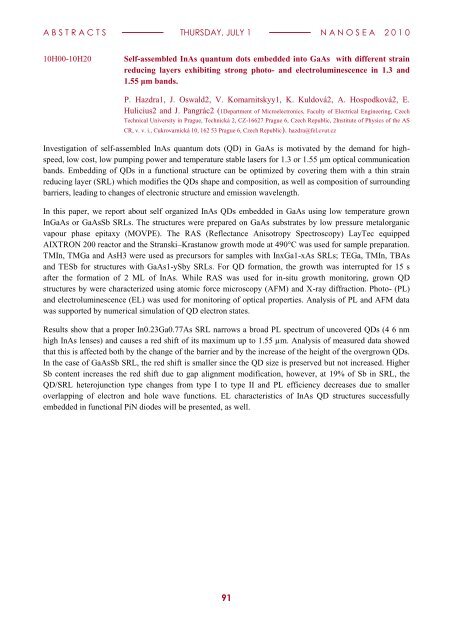book of abstracts - IM2NP
book of abstracts - IM2NP
book of abstracts - IM2NP
Create successful ePaper yourself
Turn your PDF publications into a flip-book with our unique Google optimized e-Paper software.
A B S T R A C T S THURSDAY, JULY 1 N A N O S E A 2 0 1 0<br />
10H00-10H20<br />
Self-assembled InAs quantum dots embedded into GaAs with different strain<br />
reducing layers exhibiting strong photo- and electroluminescence in 1.3 and<br />
1.55 μm bands.<br />
P. Hazdra1, J. Oswald2, V. Komarnitskyy1, K. Kuldová2, A. Hospodková2, E.<br />
Hulicius2 and J. Pangrác2 (1Department <strong>of</strong> Microelectronics, Faculty <strong>of</strong> Electrical Engineering, Czech<br />
Technical University in Prague, Technická 2, CZ-16627 Prague 6, Czech Republic, 2Institute <strong>of</strong> Physics <strong>of</strong> the AS<br />
CR, v. v. i., Cukrovarnická 10, 162 53 Prague 6, Czech Republic). hazdra@fel.cvut.cz<br />
Investigation <strong>of</strong> self-assembled InAs quantum dots (QD) in GaAs is motivated by the demand for highspeed,<br />
low cost, low pumping power and temperature stable lasers for 1.3 or 1.55 μm optical communication<br />
bands. Embedding <strong>of</strong> QDs in a functional structure can be optimized by covering them with a thin strain<br />
reducing layer (SRL) which modifies the QDs shape and composition, as well as composition <strong>of</strong> surrounding<br />
barriers, leading to changes <strong>of</strong> electronic structure and emission wavelength.<br />
In this paper, we report about self organized InAs QDs embedded in GaAs using low temperature grown<br />
InGaAs or GaAsSb SRLs. The structures were prepared on GaAs substrates by low pressure metalorganic<br />
vapour phase epitaxy (MOVPE). The RAS (Reflectance Anisotropy Spectroscopy) LayTec equipped<br />
AIXTRON 200 reactor and the Stranski–Krastanow growth mode at 490°C was used for sample preparation.<br />
TMIn, TMGa and AsH3 were used as precursors for samples with InxGa1-xAs SRLs; TEGa, TMIn, TBAs<br />
and TESb for structures with GaAs1-ySby SRLs. For QD formation, the growth was interrupted for 15 s<br />
after the formation <strong>of</strong> 2 ML <strong>of</strong> InAs. While RAS was used for in-situ growth monitoring, grown QD<br />
structures by were characterized using atomic force microscopy (AFM) and X-ray diffraction. Photo- (PL)<br />
and electroluminescence (EL) was used for monitoring <strong>of</strong> optical properties. Analysis <strong>of</strong> PL and AFM data<br />
was supported by numerical simulation <strong>of</strong> QD electron states.<br />
Results show that a proper In0.23Ga0.77As SRL narrows a broad PL spectrum <strong>of</strong> uncovered QDs (4 6 nm<br />
high InAs lenses) and causes a red shift <strong>of</strong> its maximum up to 1.55 µm. Analysis <strong>of</strong> measured data showed<br />
that this is affected both by the change <strong>of</strong> the barrier and by the increase <strong>of</strong> the height <strong>of</strong> the overgrown QDs.<br />
In the case <strong>of</strong> GaAsSb SRL, the red shift is smaller since the QD size is preserved but not increased. Higher<br />
Sb content increases the red shift due to gap alignment modification, however, at 19% <strong>of</strong> Sb in SRL, the<br />
QD/SRL heterojunction type changes from type I to type II and PL efficiency decreases due to smaller<br />
overlapping <strong>of</strong> electron and hole wave functions. EL characteristics <strong>of</strong> InAs QD structures successfully<br />
embedded in functional PiN diodes will be presented, as well.<br />
91

















